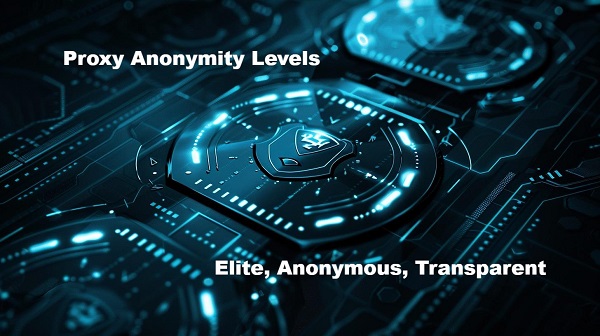3 Methods to Set Up a Reverse Proxy on a Home Network
Step-by-step guide to install and configure NGINX, Apache, or Caddy as a reverse proxy for home servers, complete with SSL, security, and troubleshooting tips.
Post Time:2025-04-29
Explore level proxies: Elite, Anonymous, and Transparent, and how to choose the right proxy anonymity levels for your tasks.
According to the anonymity feature, proxies are generally categorized into three types by their "levels". Choosing the wrong proxy can lead to data breaches or bans. In this blog, we will cover the basics of "level proxies", including what it means, the differences between various proxy levels, and how to select the right one for tasks like web scraping, anonymity, or bypassing restrictions.

A proxy server is like a relay server between your connected device and the Internet. When you request a resource, for example, a web page, the request first goes to the proxy server and then reaches the target server. Once the target server responds, the proxy server receives the data and backs to your device. This process can mask your actual IP address and further improve security and privacy.
The term "level proxies" refers to the anonymity level of a proxy server. Proxies are categorized into three main levels based on how much they conceal your identity and modify your internet traffic. These levels—commonly labeled as Level 1, Level 2, and Level 3—determine how anonymous and secure your connection will be.
Below, we detail the three main levels of proxy anonymity:
Elite proxies, also known as high anonymity proxies, offer the highest level of anonymity. They do not reveal your proxy use and completely hide your real IP address.
Key Features:
Best Use Cases:
Advantages:
Limitations:
Anonymous proxies, or semi-anonymity proxies, provide a moderate level of anonymity. They also hide your real IP address, but identify themselves as proxies to the target website. This means websites know you're using a proxy but cannot know your real IP.
Key Features:
Best Use Cases:
Advantages:
Limitations:
Transparent proxies offer the lowest level of anonymity. They forward your request along with the real IP address to the target website. Websites can easily detect you are using a proxy and identify your original IP.
Key Features:
Best Use Cases:
Advantages:
Limitations:
Selecting the right level proxy depends on your specific needs. Here are common use case examples:
1. For Web Scraping
Use Level 1 Elite Proxies to avoid detection and bans, especially websites with robust anti-bot systems.
2. For Social Media Management
Use Level 1 Elite Proxies to manage multiple accounts without risking account bans. Avoid Level 3 Transparent Proxies.
3. For General Browsing
Use Level 2 Anonymous Proxies if you just want to bypass restrictions or access geo-blocked content. Level 3 Transparent Proxies can also work, but they offer extra protection.
4. For Internal Networks
Use Level 3 Transparent Proxies for monitoring, filtering, or caching within an organization.
Finding reliable proxies at the desired anonymity level is crucial to ensure performance and security. Here are some trusted providers for different proxy levels:
1. Trusted Providers for Elite (Level 1) Proxies
Bright Data: Known for its extensive IP pool and elite-level proxies.
MacroProxy: Offers rotating residential proxies with high anonymity for web scraping and account management.
Oxylabs: Provides enterprise-grade proxies with high performance and anonymity.
2. Trusted Providers for Anonymous (Level 2) Proxies
Storm Proxies: Affordable proxies for moderate anonymity tasks.
MyPrivateProxy: Offers semi-anonymous proxies ideal for general browsing.
3. Trusted Providers for Transparent (Level 3) Proxies
ProxyMesh: Good for caching and non-sensitive tasks.
Free Proxy Lists: Publicly available transparent proxies for low-priority tasks (but use with caution).
Before deploying proxies, test their functionality and anonymity level to ensure they meet your requirements. Here’s how:
1. Use Proxy Testing Tools
Use an IP-checking website while connected to the proxy. Websites like WhatIsMyIP.com or IPLeak.net can show your visible IP address.
Expected Results:
2. Check Anonymity Levels
Tools like Proxy Checker or ProxyScrape can test whether a proxy is Elite, Anonymous, or Transparent.
3. Header Inspection
Use a web service that displays HTTP headers.
Expected Results:
4. Analyzing Behavior on Websites
Attempt to access sites that block proxies or require CAPTCHA verification.
Expected Results:
1. What level is Legendary Proxy?
Typically considered an Elite (High Anonymity) Proxy.
Characteristics:
2. What level is Senior Proxy?
Often aligns with Anonymous (Semi-Anonymity) Proxies.
Characteristics:
3. Are transparent proxies safe to use?
Transparent proxies expose your real IP address and are not suitable for tasks requiring privacy. Use them only for non-sensitive activities.
4. Can I use free proxies for Level 1 anonymity?
Free proxies rarely offer elite-level anonymity and may compromise your data. It’s better to invest in paid proxies for sensitive tasks.
5. How often should I rotate Level 1 proxies?
For tasks like scraping, rotate proxies frequently (e.g., after every request) to avoid detection and bans.
6. Are Level 2 proxies suitable for web scraping?
Level 2 proxies can work for low-risk scraping tasks, but Level 1 proxies are recommended for higher success rates and better anonymity.
We hope this blog can help you better understand level proxies and make informed decisions when choosing proxies. Whether you require maximum anonymity for web scraping or a simple solution for bypassing restrictions, we offer a vast IP pool for your tasks.
For privacy-focused tasks, Level 1 Elite Proxies are the gold standard;
while Level 2 Anonymous Proxies strike a balance between anonymity and accessibility;
Level 3 Transparent Proxies are best reserved for non-sensitive tasks where anonymity is not a priority.
Choose the right proxies, test their functionality, and use them responsibly to achieve your goals without compromising security or performance.
< Previous
Next >